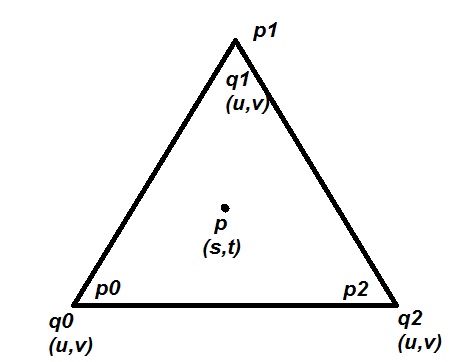I'm struggling a bit with an exercise I'm trying to do.
Here's the statement in my book:
"Let p0, p1, p2 be the vertices of a 3D Triangle with respective tex coords q0, q1 and 2.
For an arbitrary point on a 3D triangle P(s,t) = p0 + s(q1 - q0) + t(q2 - q0), where s >= 0, t >=0 and t <= 1, it's texture coordinates (u,v) are found by linearly interpolating the vertex texture coordinates across the 3D triangle by the same s, t parameters:
(u, v) = q0 + s(q1 - q0) + t(q2 - q0)"
Reading this, I understand that you can calculate the UV coordinates of a pixel/ point on a triangle, if you know the 3 UV coordinates of the 3 vertices of the triangle. Funtionally, I understand this. But the formula doesn't really make sense to me yet.
I've drawn this just for illustration:

Say I now the UV coordinates of p0,p1,p2, being q0, q1 and q2.
Then the formula states you can calculate the UV coordinates at the point 'p'.
For example:
p0 = -1, -1, 0
p1 = 0, 0, 0
p2 = 1, -1, 0
q0 = 0, 1.0
q1 = 0.5, 0.0
q2 = 1.0, 1.0
And p = 0, -0.5, 0
Then apply the formula:
(u, v) = q0 + s(q1 - q0) + t(q2 - q0)
I have no s and no t, maybe a stupid question, but how do I apply the formula?
That's my first question.
After I figure this out, I might also want to ask some help on the follow up questions:
a. Given (u,v) and q0, q1, q2, solve for (s,t) in terms of u and v
(sounds like 'shuffling' the formula above, where I have 5 known and 2 unknowns)
b. Express 'p' as a function of u and v; find a formula p = p (u,v)
c. Compute vectors .p/.u and .p/.v and give a geometric interpretation of what these vectors mean
(I could maybe draw these on the sample drawing above)
Just to be sure, I'm not looking for the end resulting answers, just trying to learn and understand (also how to get to the answer).
Any help is appreciated.








